Author: HashKey Chain
In January 2025, Coinbase and EY-Parthenon conducted a survey of 352 institutional decision-makers, revealing that 83% of respondents plan to expand their cryptocurrency allocations this year, and 59% intend to allocate more than 5% of their asset management scale to crypto assets in 2025.
A very clear signal has been sent:
As the regulatory environment becomes increasingly clear and broader use cases emerge, institutional confidence in crypto assets is strengthening. With unprecedented institutional participation, 2025 will be a significant turning point for the explosion of on-chain finance.
As a crucial infrastructure for on-chain finance, how can blockchain better support the development of on-chain finance, accommodating more funds, users, and complex financial activities?
This is a battleground of hard power, and crypto leaders are ready to compete.
This includes the implementation of crypto-friendly policies by the U.S. government and the active crypto initiatives by the president, generating heat and traffic, with U.S. concept crypto companies frequently at the forefront of public opinion. As the most representative crypto company in the U.S., Coinbase is not only a guest at the White House Digital Assets Summit but is also rapidly promoting the prosperous development of on-chain finance through its high-performance L2 Base via the compliant stablecoin USDC.
Meanwhile, in the Eastern world, a transformative force surrounding the tokenization of financial products has also begun to brew:
As Asia's leading digital asset financial services group, HashKey has officially launched the HashKey Chain mainnet, a preferred public chain for finance and RWA, aimed at building a secure, compliant, and efficient blockchain ecosystem, and promoting the deep integration of DeFi and traditional finance through the tokenization of financial products.
Under the prevailing trend, a battle for discourse power in on-chain finance has already begun. In this competition with an uncertain landscape, who will emerge victorious?
This report aims to explore the opportunities for the explosion of on-chain finance in 2025, how blockchain platforms should carry value, and the key factors for becoming important infrastructure for on-chain finance.
From Off-Chain to On-Chain: An Inevitable Choice for Financial Development
The history of human financial development can be seen as a microcosm of human civilization's progress.
From the ancient Babylonians in the Mesopotamian civilization around 2400 BC, who first conceived the idea of interest, to medieval Italy, the center of the Renaissance that nurtured the early forms of modern banking, to the 17th-century Age of Exploration when the Dutch issued the world's first stock, and to the post-World War II reconstruction of the world order, where Wall Street under the gold standard became the barometer of global finance.
We can see that since the dawn of human civilization, finance has been intertwined with our economic lives;
Every qualitative breakthrough in finance has occurred during significant transformations in human social productivity;
And every leap in the financial industry has pursued more efficient capital flow and resource allocation.
Now, in the context of intensified global geopolitical conflicts, the multipolar monetary system challenging the dollar's hegemony, and the rise of the digital economy, we once again stand at a crucial juncture witnessing another leap in human finance.

On-chain finance, built on blockchain technology, is becoming a backbone force driving significant changes in finance due to its substantial advantages in eliminating the entrenched issues of traditional finance.
Decentralization is a prominent feature of on-chain finance, which not only eliminates reliance on a single institution, laying a solid foundation for inclusive finance, but also ensures that all transaction records are publicly transparent and immutable through blockchain's distributed ledger, greatly enhancing the transparency of the financial system.
The significant improvement in capital efficiency is the core advantage of on-chain finance. While traditional finance is constrained by sovereign nations, monetary systems, and geographical environments, leading to low transaction efficiency and high friction, on-chain finance provides an effective solution for the efficient flow of capital on a global scale. At the same time, on-chain finance offers 24/7 service through smart contracts and automated processes, delivering a financial experience that is efficient, low-cost, and accessible anytime, anywhere.
More importantly, another major role of finance is to leverage greater returns through leverage. On-chain finance can provide capital gains several times higher than traditional finance by optimizing resource allocation, reducing transaction costs, and shortening investment cycles, making it more attractive for both traditional financial institutions and investors.
As blockchain technology continues to improve in performance, on-chain finance is expected to become the core engine for capital flow and resource allocation, driving human society towards a more efficient, fair, and sustainable financial future. With the dawn of 2025, on-chain finance is also poised for an explosive opportunity under the trend of clearer regulations and eager institutions.
2025: The Eve of the Full Explosion of On-Chain Finance
As early as 2024, several milestones laid a solid foundation for the development of on-chain finance.
In January 2024, we witnessed the approval of the Bitcoin ETF, a historic moment that eliminated the complexities and technical barriers of directly purchasing, storing, and managing Bitcoin, opening the door for mainstream participation and attracting significant institutional funds:
According to Coinglass data, the total net asset value of Bitcoin spot ETFs is currently about $100 billion, including: IBIT (BlackRock) holding approximately $46.3 billion; FBTC holding approximately $16.2 billion; and GBTC (Grayscale) holding approximately $15.8 billion.
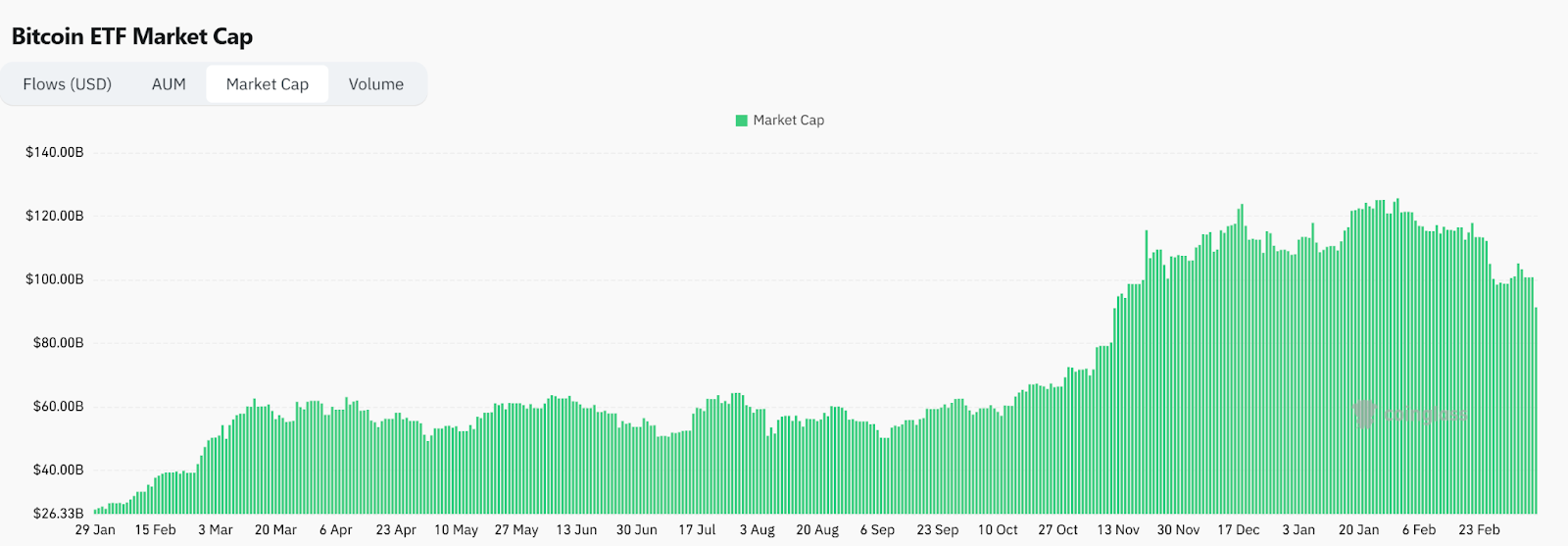
The Ethereum ETF followed closely behind, gaining approval, though its scale is far less than Bitcoin's, it still achieved impressive results: according to SoSoValue data, the total fund size of Ethereum spot ETFs is currently about $6 billion, including: ETHE (Grayscale) holding approximately $2.5 billion; and ETHA (BlackRock) holding approximately $2.4 billion.
Beyond ETFs, several sectors closely related to on-chain finance have experienced explosive growth, building important bridges for the integration of on-chain finance and traditional finance.
In 2024, RWA saw explosive growth, with a total value exceeding $19 billion (excluding stablecoins), an annual growth of over 85%, with tokenized credit, tokenized government bonds, and tokenized real estate being the main driving forces.
Additionally, according to Coinglass data, the annual trading volume of stablecoins in 2024 exceeded $8.3 trillion, with a total market capitalization exceeding $210 billion. Meanwhile, traditional giants such as Stripe, PayPal, and SpaceX have also made moves in the stablecoin sector.
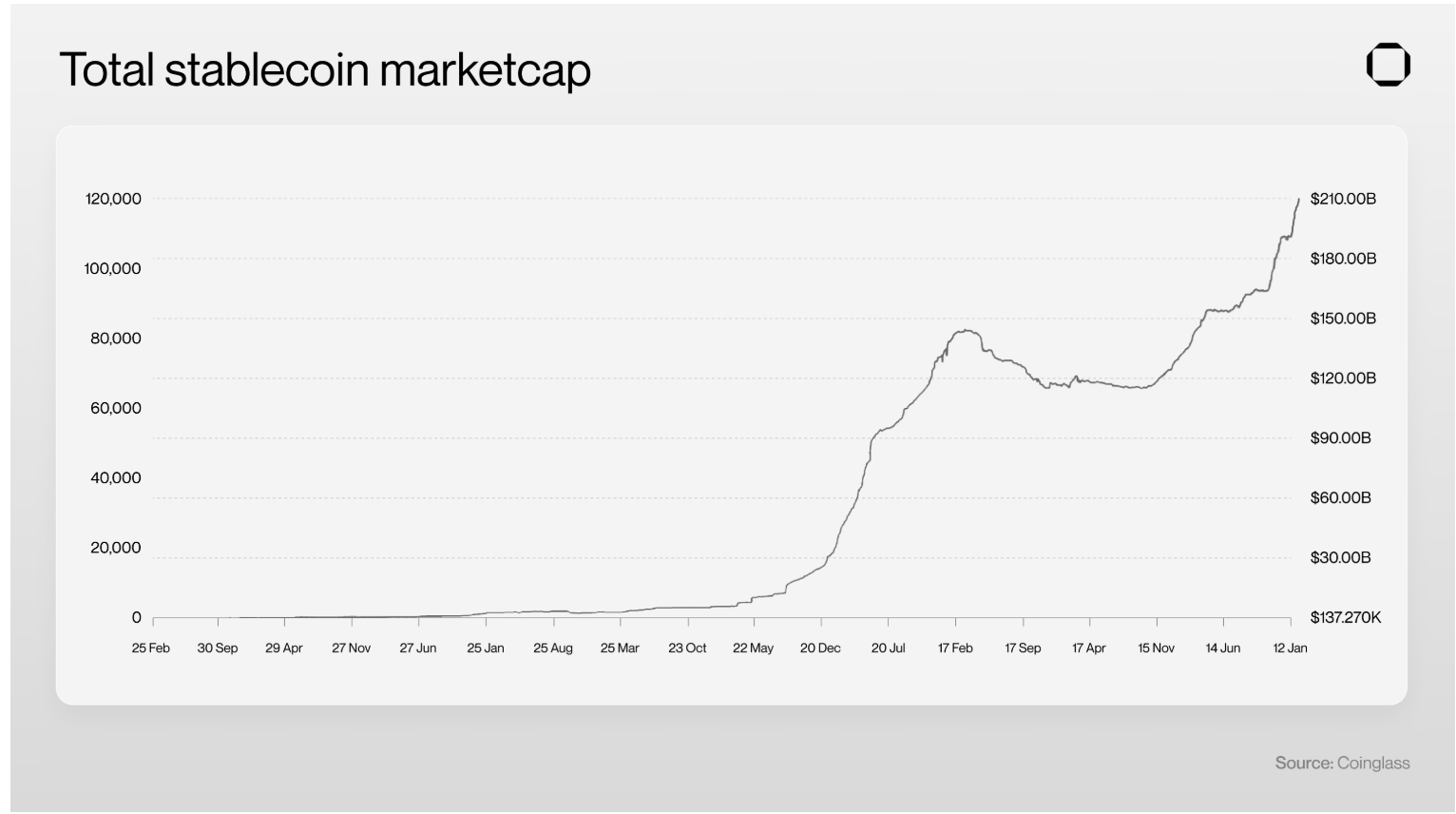
At the same time, in November 2024, Trump's victory in the U.S. election brought more optimistic expectations for the explosion of on-chain finance.
This unpredictable U.S. president has been tirelessly practicing a crypto-friendly attitude even before officially taking office: not only did he make a grand appearance at the Bitcoin 2024 conference in Nashville, but the emergence of the $TRUMP Meme also showcased his significant influence in the crypto space.
Just two months after taking office, the Trump administration had already implemented dozens of crypto policies, including signing the executive order "Strengthening America's Leadership in Digital Financial Technology," the SEC forming a special crypto task force and dropping lawsuits against several crypto companies, overturning the IRS's DeFi broker rules, and announcing five major crypto strategic reserves including BTC, ETH, XRP, SOL, and ADA.
Under the slogan "Make America Great Again," Crypto has clearly become an important tool for the U.S. to solidify its position as the "global financial heart."

In fact, the influence of this crypto-friendly atmosphere in the U.S. is not limited to America.
With on-chain finance blooming globally, many countries are forced to confront the premise of crypto regulation, and many U.S. regulatory policies provide excellent examples that will trigger follow-up actions from other countries/regions, thus promoting the establishment of clearer crypto regulatory frameworks. For instance, the EU's "Markets in Crypto-Assets Regulation" (MiCA), which officially took effect in early 2025, further provides a "model" for crypto development in European countries.
Compared to the Western world led by the U.S., the competition among Eastern countries/regions to promote clear regulations and seize the on-chain finance market is even more intense. Previously, countries such as Hong Kong, South Korea, Japan, Singapore, Thailand, India, and Dubai have introduced relevant policies to regulate the development of the crypto economy.
As on-chain finance becomes a consensus in both the East and West in 2025, Eastern countries/regions are exploring crypto regulation in a more open and proactive manner. Taking Hong Kong, an international financial hub, as an example, the Hong Kong Securities and Futures Commission (SFC) recently released a roadmap for the Hong Kong virtual asset market, "A - S - P - I - Re," which includes 12 specific measures aimed at further focusing on the participation of institutional investors.
If the high capital efficiency of on-chain finance is the original driving force for traditional finance to accelerate its transition to on-chain, then a clearer, more open, and inclusive regulatory environment further alleviates the concerns of traditional finance about going on-chain, encouraging institutions to adopt more proactive on-chain strategies.
In fact, this trend has already become apparent:
In the Western world, institutions such as JPMorgan, Goldman Sachs, BlackRock, and MicroStrategy, as well as well-known institutions in the Eastern world such as Sony, Samsung, and HSBC, have all taken concrete actions.
Another very obvious phenomenon is reflected in the surge of ETF applications. Currently, multiple institutions have submitted ETF applications to the SEC, including Ripple (XRP), Solana (SOL), Litecoin (LTC), Cardano (ADA), Hedera (HBAR), Polkadot (DOT), and Dogecoin (DOGE).
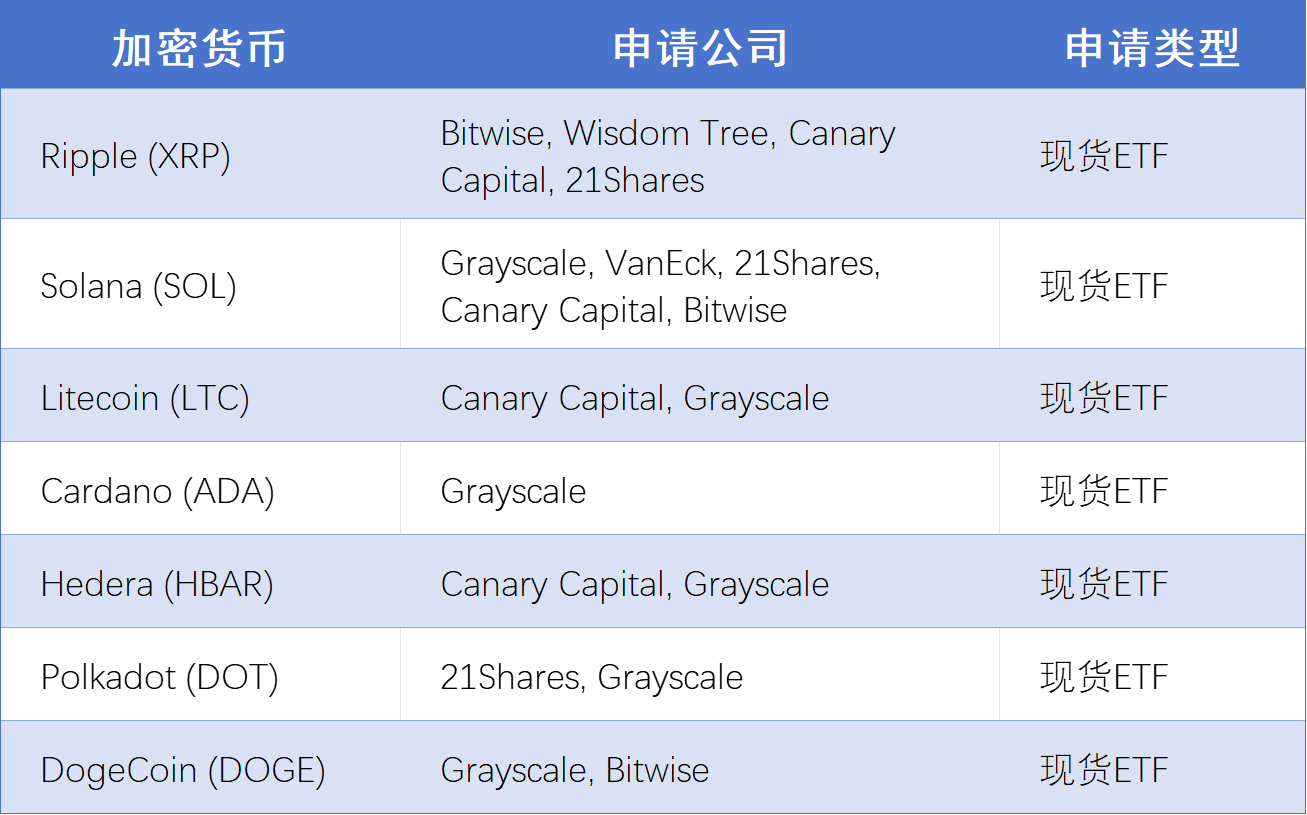
As institutions flood in with more funds and users, 2025 will become a significant turning point for the explosion of on-chain finance.
In the face of this trend, how can one become a major competitor at the on-chain finance table? Internal and external cultivation becomes key:
Embrace compliance externally: Compliance will become the core measure for institutions participating in on-chain finance. Actively embracing regulation will further alleviate institutions' concerns about regulation, creating a healthy and stable environment for the development of on-chain finance.
Cultivate internally: Continuously optimize trading speed, transaction costs, user experience, and security guarantees, while enhancing the service capabilities of blockchain as infrastructure to accommodate large-scale funds and users.
How are the main competitors performing in light of these two paths?
The Compliance Titans of East and West: A Guest at the White House and a Regulatory Pioneer in Hong Kong
Coinbase in the West, HashKey in the East.
This widely circulated analogy in the community not only stems from both having extensive crypto empires but also from their demonstrated determination and similar paths in compliance.
As the largest cryptocurrency exchange by trading volume in the U.S. and the first publicly listed crypto company in the country, Coinbase's path to compliance has been tumultuous. However, with the rise of a crypto-friendly government centered around Trump, it has gradually "seen the light after the storm":
In June 2023, the SEC announced a lawsuit against Coinbase, seeking to "permanently ban" related operations, but in February 2025, the SEC withdrew its lawsuit against Coinbase.
Meanwhile, over the past few years, Coinbase has been committed to compliant operations, holding money transfer licenses in various U.S. states and obtaining compliance operation licenses in countries including the UK, EU, Singapore, and Japan.
As a guest at the inaugural White House Digital Assets Summit, Coinbase CEO Brian Armstrong sat fourth from the left of Trump and publicly stated in media interviews that he is willing to act as the government's custodian of crypto assets in the context of national reserves. Coinbase has collaborated with multiple government departments on crypto asset custody and trading.
Additionally, Coinbase has revealed plans to actively promote the rapid implementation of stablecoin legislation and market structure bills in Congress.

As the Eastern representative, HashKey, rooted in Hong Kong, is regarded by many community members as a true pioneer in compliance:
Hong Kong not only boasts a superior geographical location, linking mainland China, Singapore, Japan, South Korea, and Southeast Asia, playing a crucial role as an important financial hub in the Asia-Pacific region, but also, as one of the former Four Asian Tigers, it possesses a well-established financial infrastructure, an active atmosphere for financial innovation, and a long-term accumulation of professionals in finance, technology, and law that other cities cannot match.
Previously, Hong Kong's fertile financial ground successfully nurtured many leading crypto institutions such as Amber Group, Crypto.com, and BitMEX. According to the Hong Kong Invest Hong Kong's "Hong Kong Fintech Ecosystem Report," there are currently over 1,100 fintech companies in Hong Kong, including 175 blockchain application or software companies and 111 digital asset and cryptocurrency companies.
In 2023, Hong Kong further clarified its direction of "focusing on blockchain as a key development area" and officially launched the licensing application system for Virtual Asset Service Providers (VASP). With a series of policies gradually opening up innovative products such as ETFs and virtual asset funds to ordinary investors, Hong Kong is gaining global attention as a "center for on-chain financial innovation."

As one of the first crypto companies to apply for a license in Hong Kong, HashKey is also a significant force supporting Hong Kong's vigorous development of the blockchain economy and actively embracing compliance. HashKey has officially obtained the Type 1, Type 4, and Type 9 licenses issued by the Hong Kong Securities and Futures Commission (SFC), expanding its business scope and capabilities under the SFC's regulation.
Starting from Hong Kong, HashKey has rapidly advanced its compliance processes in multiple countries over the past year, obtaining the Major Payment Institution license from the Monetary Authority of Singapore (MAS), a crypto exchange operating license in Japan, an F license from the Bermuda Monetary Authority (BMA), and the principle approval (IPA) for its VASP license application from the Dubai Virtual Assets Regulatory Authority (VARA).

At the same time, HashKey Group has stated that it will continue to promote a global licensed matrix over the next five years, expanding into markets including the Middle East and Europe, gradually extending its on-chain financial service capabilities globally.
As the chain specifically designed for on-chain finance and RWA, HashKey Chain will continue to leverage HashKey's compliance advantages, aiming to build a compliance-oriented on-chain financial infrastructure and create a full-stack solution connecting Web2 and Web3.
The momentum brought by compliance to HashKey is also reflected in the growth of specific business areas, especially in institutional collaborations:
In 2025, HashKey Chain not only successfully launched the Bosera HashKey BTC ETF and Bosera HashKey ETH ETF but also established deep collaborations with well-known institutions such as Futu Securities, Tiger Brokers, Cinda International Asset Management, and ZhongAn Bank.
Meanwhile, HashKey Exchange attracted over HKD 10 billion in assets, with cumulative trading volume exceeding HKD 600 billion.
Beyond similar compliance paths, blockchain serves as the infrastructure for on-chain finance, and both Coinbase and HashKey have launched their L2 crypto asset management groups, allowing us to easily focus on Base and HashKey Chain.
The Foundation of On-Chain Finance: The Game of Compliant Stablecoins and Financial Product Tokenization
We can find many commonalities between Base and HashKey Chain.
As infrastructures, both aim to become the next generation of on-chain financial technology foundations, and both are working hard to optimize performance to better accommodate large-scale funds and users.
The Base mainnet was officially launched in 2023 and has become one of the hottest L2s in less than two years. According to Artemis data, in the fourth quarter of 2024, Base's net capital inflow exceeded USD 2.5 billion, with daily transaction counts around 11.1 million. During the AI Agent and Meme craze of 2024, Base demonstrated strong capital attraction and the ability to support frequent on-chain interactions from large-scale users.
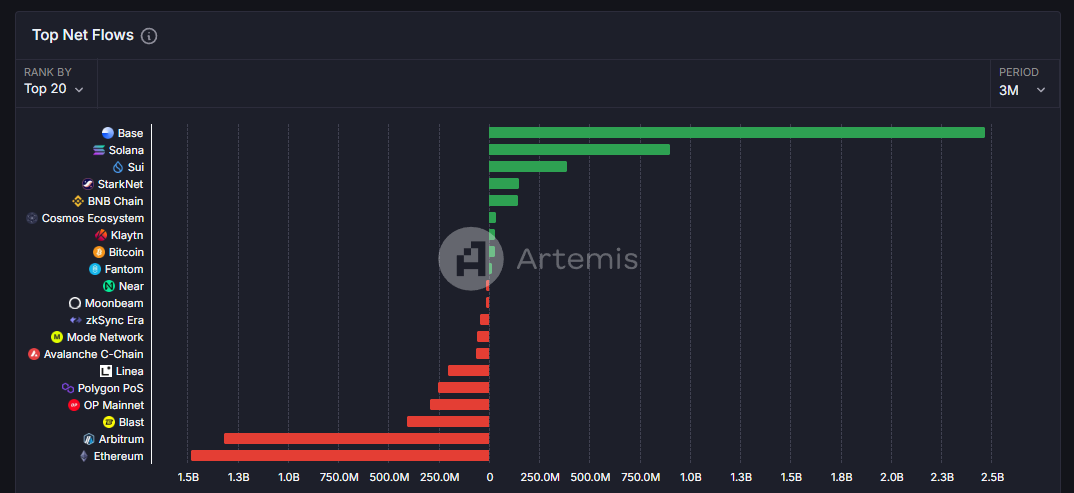
In contrast, HashKey Chain, although launched for just over two months, shows its ambition to create a preferred blockchain for finance and RWA through rapidly growing on-chain data and a series of features designed for institutional adoption.
As an Ethereum Layer 2 built on the OP Stack, HashKey Chain has advantages such as EVM compatibility, high throughput, and scalability. According to publicly available data, HashKey Chain has an average block time of 2 seconds, gas fees as low as 0.1 Gwei, and TPS can reach 400, aiming to provide an outstanding on-chain financial interaction experience.
During the testnet phase, HashKey Chain completed a total of 25.816 million transactions; over 870,000 wallet addresses were registered; and 300,000 community members participated. According to hashkey.blockscout data, in just over two months since the mainnet launch, HashKey Chain's total transaction volume exceeded 8.34 million, with total addresses surpassing 208,000.

At the same time, for institutions with large capital volumes, security is their primary consideration for participating in on-chain finance, and HashKey Chain has made ample preparations for this:
HashKey Chain's smart escape pod synchronizes the state Merkle tree to Layer 1 at fixed block intervals, ensuring the ultimate security of assets.
Additionally, multi-level DAO governance allows the security committee DAO to respond quickly to potential security threats, while the technical audit DAO focuses on in-depth analysis and verification, further enhancing HashKey Chain's security factor.
Furthermore, through collaboration with Chainlink, Chainlink CCIP will serve as HashKey Chain's standard cross-chain infrastructure, effectively avoiding common cross-chain security issues such as double-spending attacks and cross-chain reentrancy attacks, ensuring that HashKey Chain provides reliable and secure cross-chain services. Chainlink Data Streams will serve as HashKey Chain's official data solution, bringing low-latency, real-time, tamper-proof market data to HashKey Chain, opening the door to innovations in high-frequency trading and derivatives trading scenarios.
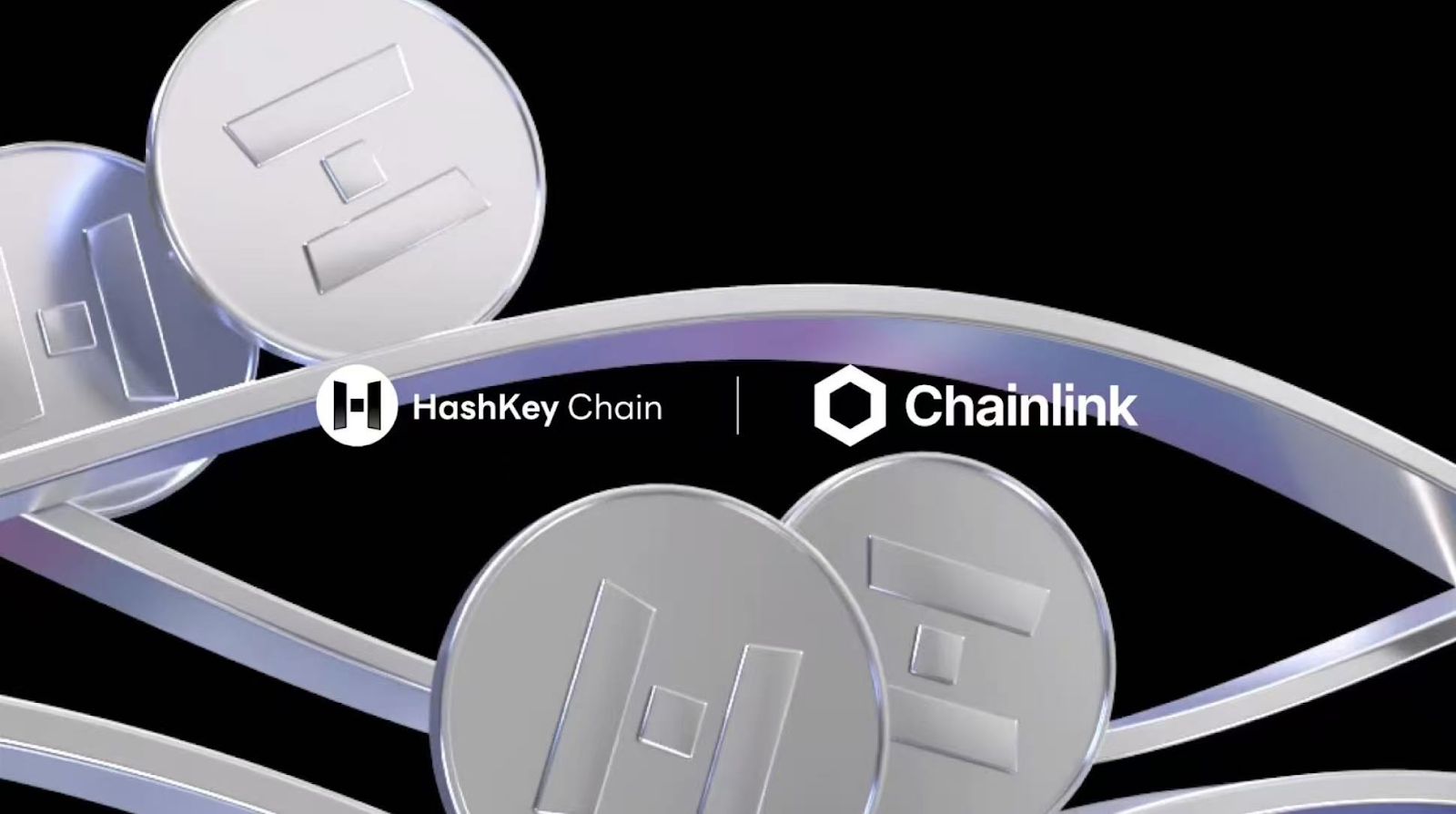
Of course, in the arms race of public chain infrastructure, the soft power of ecological construction is receiving more attention beyond the hard power of performance.
In this regard, while both Base and HashKey Chain are committed to seizing the opportunities for on-chain financial development in 2025, they have different plans for their ecological entry points.
Base focuses on the compliant stablecoin USDC as its main lever:
Stablecoins provide a stable medium of exchange, serving as a bridge for rapid conversion and efficient liquidity between different crypto assets. Their importance is self-evident, and compliant stablecoins further provide a pathway for traditional financial funds to participate in on-chain financial activities, significantly promoting the penetration of the Base ecosystem into more financial scenarios such as payments and RWA, and attracting institutional participation.
In 2018, Circle and Coinbase jointly launched the first stablecoin supported by centralized exchanges, USDC, with Coinbase primarily responsible for the USD reserves backing USDC. USDC's main advantage is compliance, as its two major issuers, Circle, hold full licenses in the U.S. and payment licenses in the UK and EU, while Coinbase's compliance advantages are also noteworthy. Last July, Circle obtained the qualification to issue USDC and EURC under the MiCA legislation.
Through the compliant stablecoin USDC, Base not only provides developers and users with a higher quality on-chain financial experience, such as gas fee discounts when users pay with USDC, but also promotes the integration and expansion of the Base ecosystem with traditional finance: currently, several native stablecoin payment applications such as Peanut and LlamaPay have emerged in the Base ecosystem.
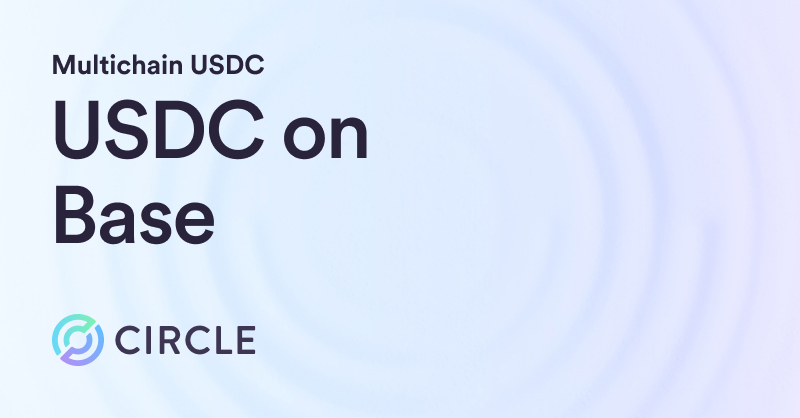
On the other hand, HashKey continues to leverage its advantages in institutional collaboration, focusing on the tokenization of financial products to build a preferred blockchain for finance and RWA:
Institutions manage large-scale funds and users, and their participation will guide significant on-chain capital accumulation and the influx of new users, marking an important sign of the maturity and scaling of on-chain finance. HashKey Chain aims to clear obstacles for institutional participation by providing efficient and compliant financial product tokenization solutions.
The tokenized U.S. dollar money market fund "CPIC Estable MMF," initiated and managed by China Pacific Insurance Investment Management Co., Ltd. (Hong Kong), has successfully deployed on HashKey Chain, serving as a demonstration case of HashKey Chain's focus on financial product tokenization and building a preferred platform for finance and RWA.
For institutions, HashKey Chain significantly lowers the technical barriers and operational costs of bringing financial products on-chain by empowering asset liquidity and application scenarios through a compliant, secure, high-performance, low-cost, and comprehensive on-chain DeFi ecosystem. This enables CPIC Estable MMF to serve as an effective digital asset allocation tool, helping institutions achieve transparent, efficient, and refined management of fund shares on the blockchain.
For DeFi users, by providing institutions with efficient financial product tokenization tools, on-chain financial users will welcome more quality assets with real returns and gain access to a more diverse range of income sources.
As more institutional assets choose to undergo digital transformation on HashKey Chain, on-chain finance is accelerating its integration with traditional finance and playing an increasingly important role in the global financial system.
According to HashKey data, the subscription scale of CPIC Estable MMF exceeded USD 100 million on its first day of operation, further reflecting the enormous market demand for institutional financial product tokenization. As HashKey Chain continues to deepen cooperation with multiple institutions, it will further become an ideal platform for the tokenization of financial products such as bonds, funds, and stablecoins, facilitating the leap in on-chain finance and RWA.
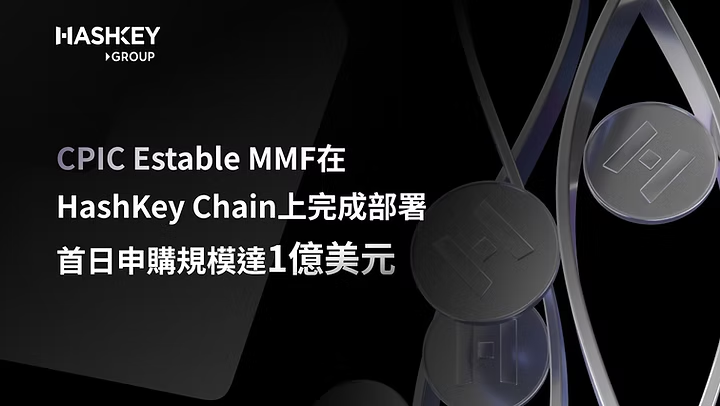
Both paths have their merits, each carrying the grand vision of propelling the explosion of on-chain finance and achieving breakthrough accomplishments at their respective entry points. However, as on-chain finance is still in its early stages, perhaps both Base and HashKey Chain need more specific scenarios that deeply integrate off-chain and on-chain finance to validate their feasibility. A longer-term perspective is also necessary.
In predicting the future, perhaps the 2025 roadmaps released by both can provide more long-term insights.
Multiple Measures in Parallel: Welcoming the Golden Age of On-Chain Financial Development
In the 2025 roadmap released by Base, we can clearly see the dual-track parallel of technology and ecology:
On the technology front, Base will focus on OnchainKit, Paymaster, and L3 to enhance the experience;
On the ecological front, Base aims to connect over 25 fiat channels and is committed to attracting 25 million users and 25,000 developers, while also targeting a scale of on-chain assets reaching USD 100 billion within the year.
Compared to Base's grand data vision, HashKey Chain's 2025 roadmap focuses on tracks such as BTCFi, PayFi, RWA, and stablecoins, introducing more specific measures aimed at expanding developer scale, attracting large-scale capital on-chain, and building a compliance-oriented on-chain financial infrastructure.
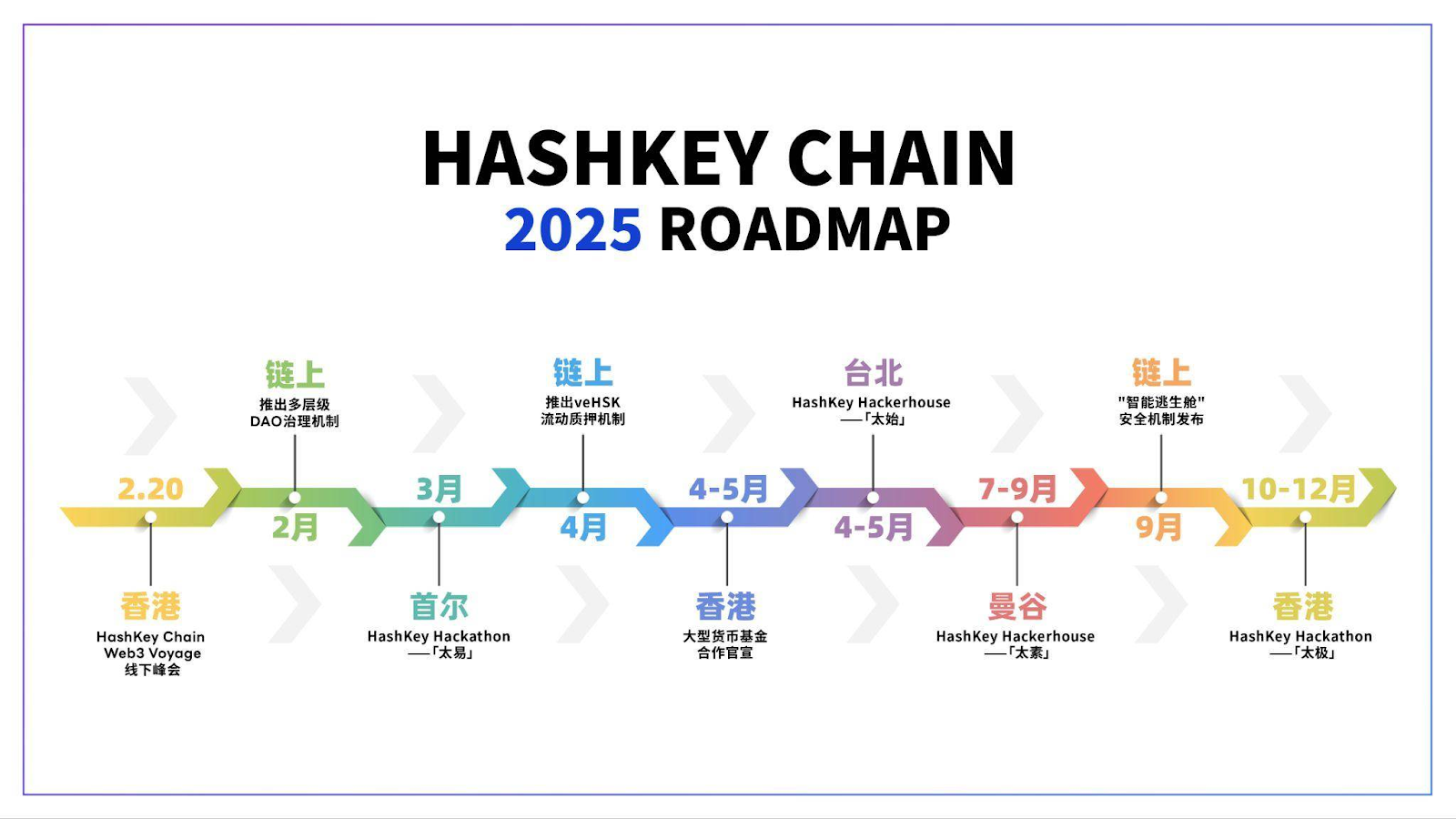
On one hand, the Wrapped BTC asset HashKey BTC (HBTC) issued by HashKey Chain is on the way:
This product aims to focus on the trillion-dollar BTCFi market, providing users with compliant and robust on-chain returns, including lending returns, liquidity mining returns, re-staking returns, and HashKey points.
On the other hand, with the vision of being "the first blockchain for finance and RWA," HashKey Chain will continue to focus on the RWA track, continuously enhancing its tokenization services for institutional financial products:
Previously, HashKey Group collaborated with Cinda International Asset Management to launch the first STBL project issued by a Hong Kong financial institution. The assets related to STBL are composed of AAA-rated money market fund (MMF) portfolios, with each STBL having a par value of USD 1, transferable 24/7, and automatically distributing daily accumulated interest to professional investors' wallets in the form of newly issued tokens on each monthly dividend day. In the near future, the issuance of STBL will expand to HashKey Chain.
At the same time, HashKey Chain will also promote the tokenization of traditional asset fields such as real estate, commodities, and artworks, enhancing asset liquidity and market transparency.
More importantly, based on deep cooperative relationships with multiple institutions, HashKey Chain's Hong Kong dollar stablecoin is in the works:
Previously, HashKey Exchange has reached cooperation with Yuan Coin Technology, Allinpay International, and other companies, and the Hong Kong dollar stablecoin issued based on HashKey Chain will soon be unveiled. The stablecoin ecosystem based on HashKey Chain will further promote the prosperous development of cross-border payments and decentralized financial solutions on HashKey Chain, accelerating the on-chain transformation of global finance.
On the developer front, multiple developer incentive policies also demonstrate HashKey Chain's determination to build on-chain finance:
As HashKey Chain's mainnet officially launched, the Atlas Grant program with a total prize pool of USD 50 million was immediately introduced. This program aims to deeply explore quality projects in the Web3 field and provide comprehensive empowerment, facilitating exponential growth for HashKey Chain's application layer and on-chain users. The first phase of the Atlas Grant ended on January 20, 2025, with the second, third, fourth, and fifth phases set to launch in Q2, Q3, and Q4 of 2025.
In addition, a series of HashKey Hacker House and Hackathon events will soon be held in multiple cities worldwide, including South Korea, Taiwan, Japan, and Thailand, providing developers with a platform for communication and direct dialogue with core team members of HashKey Chain to gain support.

From embracing compliance to building a safe, efficient, and institution-friendly diversified on-chain financial ecosystem focusing on BTCFi, RWA, and stablecoins, HashKey is becoming an important force in promoting the deep integration of on-chain finance and traditional finance.
Whether it is the Western Coinbase and its high-performance Layer 2 Base, or the Eastern HashKey and its preferred public chain for finance and RWA, HashKey Chain, both are driving the prosperous development of on-chain finance in their own ways. This parallel pattern of East and West not only showcases the diversified paths of on-chain finance but also reveals the profound trends of transformation in the global financial system.
As the community puts it:
Western Coinbase, Eastern HashKey
Western Base, Eastern HashKey Chain
Perhaps under the nearly irreversible trend of clearer regulation and the continuous entry of institutions, it is better to say that both are co-building rather than competing.
With San Francisco, where Coinbase is located, and Hong Kong, where HashKey is based, as two focal points, and with Base's compliant stablecoin and HashKey Chain's institutional financial product tokenization as two major levers, facing the golden age of the comprehensive explosion of on-chain finance, we can perhaps look forward to a future where both Base and HashKey Chain will promote the construction of on-chain financial order in the East and West in a win-win manner, while accelerating the earlier arrival of global on-chain financial transformation.
免责声明:本文章仅代表作者个人观点,不代表本平台的立场和观点。本文章仅供信息分享,不构成对任何人的任何投资建议。用户与作者之间的任何争议,与本平台无关。如网页中刊载的文章或图片涉及侵权,请提供相关的权利证明和身份证明发送邮件到support@aicoin.com,本平台相关工作人员将会进行核查。




